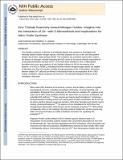Zinc Thiolate Reactivity toward Nitrogen Oxides: Insights into the Interaction of Zn[superscript 2+] with S-Nitrosothiols and Implications for Nitric Oxide Synthase
Author(s)
Kozhukh, Julia; Lippard, Stephen J.
DownloadLippard_Zinc thiolate.pdf (800.0Kb)
PUBLISHER_POLICY
Publisher Policy
Article is made available in accordance with the publisher's policy and may be subject to US copyright law. Please refer to the publisher's site for terms of use.
Terms of use
Metadata
Show full item recordAbstract
Zinc thiolate complexes containing N[subscript 2]S tridentate ligands were prepared to investigate their reactivity toward reactive nitrogen species, chemistry proposed to occur at the zinc tetracysteine thiolate site of nitric oxide synthase (NOS). The complexes are unreactive toward nitric oxide (NO) in the absence of dioxygen, strongly indicating that NO cannot be the species directly responsible for S-nitrosothiol formation and loss of Zn[superscript 2+] at the NOS dimer interface in vivo. S-Nitrosothiol formation does occur upon exposure of zinc thiolate solutions to NO in the presence of air, however, or to NO[subscript 2] or NOBF[subscript 4], indicating that these reactive nitrogen/oxygen species are capable of liberating zinc from the enzyme, possibly through generation of the S-nitrosothiol. Interaction between simple Zn[superscript 2+] salts and preformed S-nitrosothiols leads to decomposition of the −SNO moiety, resulting in release of gaseous NO and N[subscript 2]O. The potential biological relevance of this chemistry is discussed.
Date issued
2012-06Department
Massachusetts Institute of Technology. Department of ChemistryJournal
Inorganic Chemistry
Publisher
American Chemical Society (ACS)
Citation
Kozhukh, Julia, and Stephen J. Lippard. “Zinc Thiolate Reactivity toward Nitrogen Oxides: Insights into the Interaction of Zn2+ with S-Nitrosothiols and Implications for Nitric Oxide Synthase.” Inorganic Chemistry 51, no. 13 (July 2, 2012): 7346-7353.
Version: Author's final manuscript
ISSN
0020-1669
1520-510X